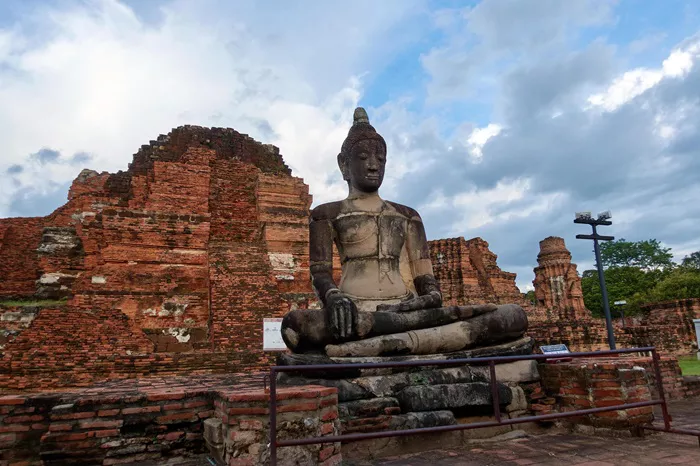Wat Mahathat is one of the most important and famous Buddhist temples in Thailand. It holds great spiritual, historical, and cultural value for Buddhists and visitors alike. This temple is well-known for its unique Buddhist architecture and its role in preserving ancient temple architecture traditions. Many come here to learn about Buddhism and to appreciate the peaceful atmosphere that surrounds it.
The History of Wat Mahathat
Origins and Founding
Wat Mahathat was built in the 14th century during the Ayutthaya period. It was established as the main temple for religious activities in the city of Ayutthaya, which was once the capital of Thailand. The temple’s name, “Mahathat,” means “Great Relic,” referring to the sacred relics of the Buddha that were kept here. This made the temple a center for pilgrimage and worship.
Role in Thai Buddhism
Wat Mahathat served as the spiritual heart of Ayutthaya for centuries. It was a place where monks studied Buddhist scriptures, meditated, and taught the local people. The temple symbolized the close connection between the Thai monarchy and Buddhism. Kings often supported Wat Mahathat to show their respect and promote Buddhist teachings throughout the kingdom.
Destruction and Restoration
In 1767, the city of Ayutthaya was attacked and destroyed by the Burmese army. Wat Mahathat, along with many other temples, was badly damaged. Over time, it fell into ruins. However, in the 20th century, Thai authorities and Buddhist organizations began efforts to restore parts of the temple. Today, it stands as a historic site where visitors can see both restored buildings and original ruins.
The Significance of Wat Mahathat
Spiritual Importance
Wat Mahathat is deeply revered by Buddhists because it once housed relics of the Buddha himself. These relics are believed to carry blessings and spiritual power. Devotees come here to pray, meditate, and seek merit. The temple’s peaceful environment helps visitors reflect on Buddhist teachings such as compassion, mindfulness, and impermanence.
Cultural and Educational Value
This temple is a living museum of ancient temple architecture and Buddhist art. It offers insights into how Buddhist architecture evolved over centuries in Thailand. Wat Mahathat also teaches about the history of Buddhism in the region and the importance of preserving cultural heritage. Many scholars and students visit the temple for research and learning.
Tourist Attraction
Besides its religious role, Wat Mahathat is a major tourist attraction. Visitors from all over the world come to see the temple’s famous buddhist architecture and ruins. Walking through the temple grounds gives a glimpse into Thailand’s rich past and Buddhist traditions. The site also supports local communities by encouraging cultural tourism.
Must-See Highlights at Wat Mahathat
The Buddha Head in the Tree Roots
One of the most famous images at Wat Mahathat is the Buddha head wrapped in the roots of a banyan tree. This unique sight draws many visitors. The head was part of a larger Buddha statue, destroyed during the Burmese invasion. Nature has since embraced the statue’s remains, creating a beautiful symbol of harmony between the spiritual and natural world.
The Main Prang (Tower)
The temple’s main prang is a tall, pointed tower that represents Mount Meru, the center of the universe in Buddhist cosmology. This prang shows classic ancient temple architecture and features detailed carvings and decorations. Visitors can admire its design and imagine its original grandeur.
The Ruins of the Viharn and Ubosot
The viharn (assembly hall) and ubosot (ordination hall) are key parts of the temple complex. Although only ruins remain, these buildings once hosted important religious ceremonies and daily monastic life. Walking through these ruins allows visitors to feel the temple’s spiritual past and the peaceful atmosphere that still lingers.
Stone Sculptures and Reliefs
Wat Mahathat is home to many stone sculptures and carved reliefs depicting scenes from the life of the Buddha and Buddhist myths. These artistic works are valuable examples of temple architecture decoration. They help explain Buddhist teachings visually and add to the temple’s sacred ambiance.
How to Visit Wat Mahathat
Best Time to Visit
The temple is open all year round. The best time to visit is during the cooler months from November to February. Early morning or late afternoon visits are recommended to avoid the midday heat and to enjoy a calm atmosphere for meditation or photography.
Guidelines for Visitors
Visitors should dress respectfully, covering shoulders and knees, as a sign of respect in this sacred place. Removing shoes before entering certain buildings is also required. Taking photos is allowed in most areas, but silence and respectful behavior should be maintained to honor the temple’s spiritual nature.
Nearby Attractions
Wat Mahathat is located in the historical park of Ayutthaya, which contains many other famous Buddhist temples and ruins. Visitors can explore nearby sites such as Wat Ratchaburana and Wat Phra Si Sanphet to get a fuller understanding of Ayutthaya’s history and religious life.
Conclusion
Wat Mahathat is more than just an ancient temple. It is a symbol of Thai Buddhism, history, and culture. Its spiritual significance, beautiful buddhist architecture, and peaceful environment make it a must-see for anyone interested in Buddhism or history. Visiting Wat Mahathat offers a chance to connect with Buddhist teachings and appreciate the rich heritage that continues to inspire many today.

